Dan's Watch Collection
![]()
Search the Site:
![]()
Home
Orient Watches
Seiko Watches
6139 Chronograph
Seiko "Samurai"
Seiko "Land Shark"
"Orange Monster"
Seiko SKX009
Seiko 5 Sports
Seiko 5
Seiko 5 Speed Racer
Seiko 7T32 Chrono
Seiko Bellmatic
Seiko White Knight
Seiko Alpinist
Swiss Watches
Russian Watches
Asian Watches
Mixed Pedigree
Everest Custom Dial
Old Watch Ads
Watch Links
WIS Glossary
|
|
![]()
Seiko Watches from my collection
If you are looking for Seiko watch instructions and you know your caliber number, please visit http://www.seiko.co.uk/html/support.php
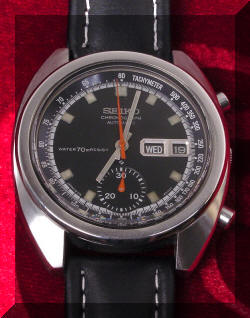
|
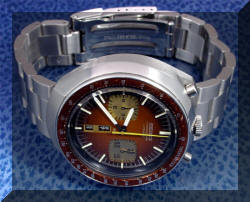
|
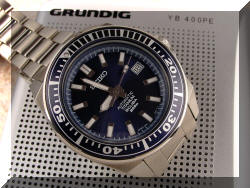
|
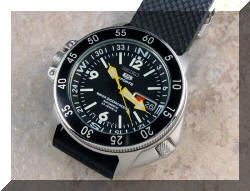
|
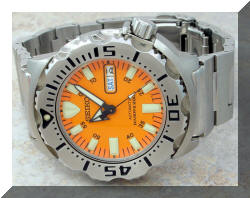
|
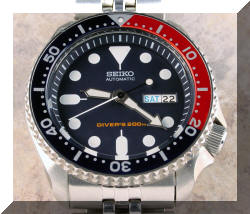
|
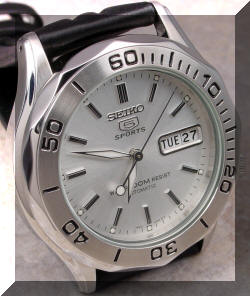
|
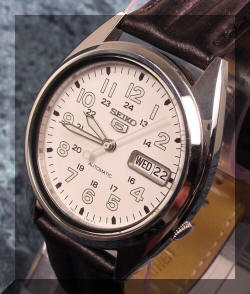
|
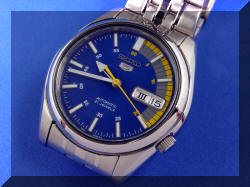
|
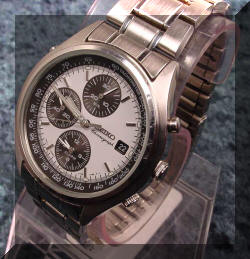
|
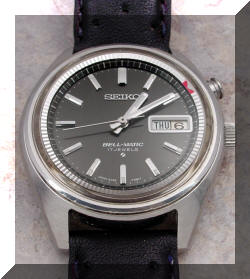
|
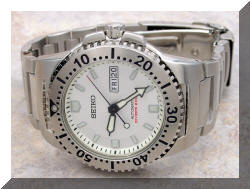
|
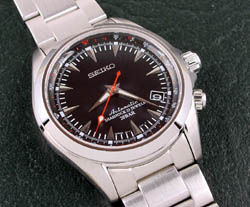
|
|
The Following History of Seiko is taken from the web page http://www.seikowatches.com/corporate/history1881.asp
1881 Establishment by Kintaro Hattori of K. Hattori & Co., Ltd.,
predecessor of today's Seiko Corporation.1892 Foundation of Seikosha clock supply factory.
Production of wall clocks begins.1895 Production of fob watches begins.
1899 Production of alarm clocks begins.
1902 Production of table clocks and musical clocks begins.
1913 Production of the first wrist watch made in Japan begins.
1917 K. Hattori & Co., Ltd. becomes a public company.
1924 Seiko brand first used on watches.
1937 Watch production split off as Daini Seikosha Co., Ltd.,
independent predecessor of today's Seiko Instruments Inc.1942 Establishment of watch producer, Daiwa Kogyo Ltd.,
predecessor of today's Seiko Epson Corporation.1955 Production of the first self-winding wrist watch made in Japan begins.
1958 Introduction of quartz clocks for broadcasting use.
1959 Introduction of transistorised table clocks.
1963 Development of portable quartz chronometer.
1964 Seiko serves as Official Timer of Tokyo Olympic Games in Japan.1968 Establishment of subsidiary in Hong Kong.
1969 Introduction of Seiko Astron, world's first quartz watch (35SQ).
1970 Establishment of subsidiary in USA.
1971 Establishment of subsidiary in UK.
Seiko Time Corporation in the USA opens its first office in Canada.1972 Establishment of subsidiary in the former Federal Republic of Germany.
Seiko serves as Official Timer of Sapporo Winter Olympic Games in Japan.
1973 Introduction of world's first LCD quartz watch with six-digit digital display (06LC).1974 Establishment of subsidiary in Brazil.
1975 Introduction of world's first multi-function digital watch.
1976 Introduction of world's first quartz alarm clock.
1977 Establishment of subsidiary in Australia.
Establishment of subsidiary in Panama.1978 Establishment of subsidiary in Switzerland.
Seiko serves as Official Timer of World Cup Soccer Championships in Argentina.
Introduction of world's first very-fine adjusted ultra-accurate Twin Quartz watch, with less than five seconds deviation per year.1979 Establishment of subsidiary in Sweden.
Introduction of Pulsar brand.
Introduction of Alba brand.1980 Establishment of subsidiary in the Netherlands.
1981 Establishment of representative office in Dubai.
Introduction of Lassale brand.1982 Seiko serves as Official Timer of World Cup Soccer Championships in Spain.
Introduction of world's first TV watch.
Introduction of Lorus brand.
1983 K. Hattori & Co., Ltd. renamed as Hattori Seiko Co., Ltd.
Introduction of world's first watch with sound-recording functions.1984 Introduction of world's first "talking" clock, the Seiko Pyramid Talk.
1986 Seiko serves as Official Timer of World Cup Soccer Championships in Mexico.
1987 Seiko serves as Official Timer of 2nd IAAF World Championships in Athletics in Italy.
1988 Introduction of quartz watch with sweep second hand.
Introduction of world's first automatic power generating quartz watch.
Introduction of world's first intelligent analogue quartz watch with alarm, chronograph and timer functions controlled by an IC "computer on a chip."1989 Establishment of subsidiary in Thailand.
1990 Hattori Seiko Co., Ltd. renamed as Seiko Corporation.
Seiko serves as Official Timer of World Cup Soccer Championships in Italy.
Introduction of the Seiko "The Age of Discovery" collection.
Introduction of the Seiko Scubamaster, world's first computerised diver's watch to incorporate a dive table.
Introduction of the Seiko Receptor Message Watch incorporating a miniaturised FM subcarrier.1991 Establishment of subsidiary in Finland.
Establishment of subsidiary in Taiwan.
Seiko serves as Official Timer of 3rd IAAF World Championships in Athletics in Tokyo, Japan.
Introduction of the Seiko Perpetual Calendar with the world's first "millennium-plus calendar".1992 Seiko serves as Official Timer of Barcelona Olympic Games in Spain.
1993 Introduction of the "S-YARD" Golf Clubs.
1994 Establishment of a representative office in Beijing.
Seiko serves as Official Timer of Lillehammer Olympic Winter Games in Norway.
Introduction of Seiko Kinetic series.1995 Introduction of Alba "Spoon" series.
1996 Establishment of Seiko Optical Products, Inc. Establishment of Seiko Clock Inc.
Establishment of Seiko Precision Inc.1997 Establishment of Seiko Jewelry Co., Ltd.
Changed Japanese company name to Seiko Kabushiki Kaisha.
Introduction of Seiko Kinetic Arctura.1998 Seiko serves as Official Timer of Nagano Olympic Winter Games in Japan.
Introduction of Perpetual Calendar watch driven by world's first ultrasonic micromotor.
Introduction of the Seiko Thermic, the world's first watch driven by body heat.1999 Introduction of the Seiko Kinetic Auto Relay watch, which automatically resumes correct indication of current time.
Introduction of hand wound spring-drive watch with quartz accuracy.2000 Establishment of Seiko S-Yard Co., Ltd.
2001 Establishment of Seiko Watch Corporation
2002 Seiko serves as Official Timer of Salt Lake City Olympic Winter Games in USA.
![]()
